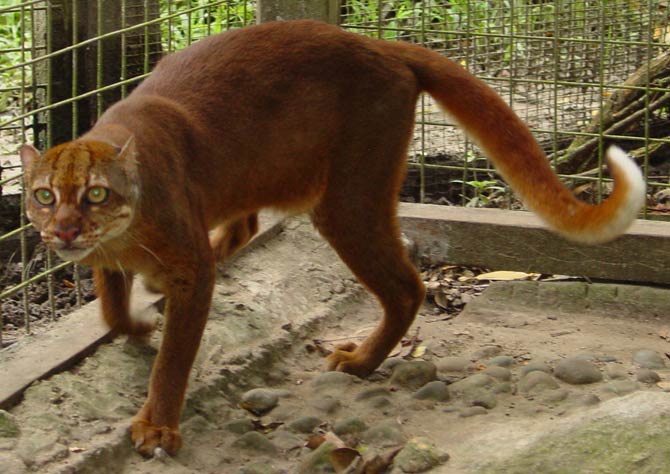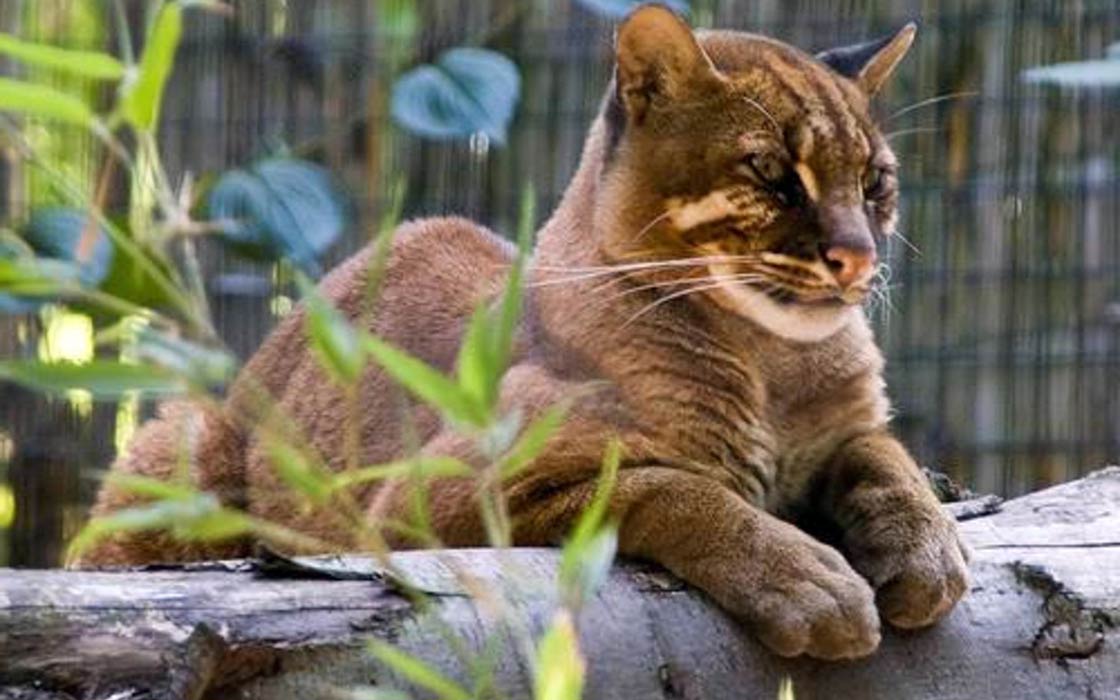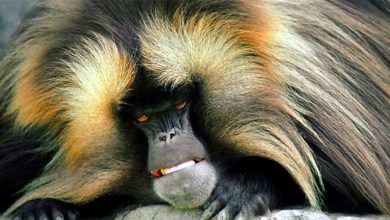Bay cat, Borneo bay cat, Bornean bay cat (Catopuma badia)
It seems that the lands are already well known. Certainly enough that no larger species of animal could hide from human sight. However, it happens that sometimes we know almost nothing even about large mammals. One of the most mysterious is a wild cat living in Borneo.
The Bay cat, also known as the Borneo bay cat or Bornean bay cat, is a predatory mammal, an endemite that lives – as the name suggests – only in Borneo. It was discovered by accident, while hunting tigers in the Malay Peninsula. Since then, the animal has been captured only a dozen or so times, and for nearly 140 years it has not been photographed in the wild.

Classification
- Kingdom: Animalia
- Phylum: Chordata
- Class: Mammalia
- Order: Carnivora
- Suborder: Feliformia
- Family: Felidae
- Subfamily: Felinae
- Genus: Catopuma
- Species: Catopuma badia
- Synonyms:
- Felis badia Gray
- Pardofelis badia

Characteristic
Appearance
The Bay cat weighs 3–4 kg (6.6–8.8 lb). Without the tail, it measures approx. 50–67 cm (19.7 – 26.4 in), while the tail itself is 30–40 cm (11.8 – 15.7 in). It should be emphasized, however, that these data were compiled from the measurements of only a dozen studies, so in fact, larger or smaller animals of this species may live.
The body is slender, chestnut in color, slightly lighter on the belly, with darker spots on the lower parts of the body. On the head there are two dark stripes running from the corner of each eye to the back of the head. The eyes are relatively large and the ears are small and rounded. The tail is narrow, pointed, there is a black spot on the upper tip of the tail.
Lifestyle
The Bay cat is not very picky when it comes to living environment – it can be found both in the mountains (at an altitude of up to 1,800 m) and in the lowlands. It lives mainly in forests, but traces of its occurrence have also been found in forestless parts of the mountains, as well as near sea coasts. The three animals have been encountered close to rivers, but are believed to have found their way there by accident while wandering, and avoid water on a daily basis.
Borneo bay cat has a very secretive nocturnal lifestyle, and as he lives in dense forests, it is extremely difficult to observe. This makes little information about him certain. It is known to hunt birds, rodents and sometimes monkeys as well. However, it is not known exactly how it hunts, e.g. whether alone or in groups. Completely nothing is known about the reproduction of this species.

Threats
Bornean bay cat is considered an extremely endangered species. The greatest threat to him is the constantly progressive deforestation in Borneo caused by the growing demand for palm plantations. While in 1980 as much as ¾ of the island was covered by forests, in 2005 forests covered only half of the island.
It was proposed to establish a network of 25 national parks in Borneo, but only three are operational and the rest are under construction. This makes it very difficult to protect a Bay cat, especially considering its secretive lifestyle.
Another threat to the Bay cat is poachers. They hunt this animal for its fur. Fortunately – judging by the relatively small number of illegally obtained furs found – poachers are rarely successful in hunting this cat.

Bay cat and science
The research on the Bay cat can be described as a series of happy coincidences. The animal was described and named by John Edward Gray in 1874 based on the skin and skull found by Alfred Russel Wallace. These trophies were found in 1856, but previously believed to be the remains of a young Asian golden cat (Catopuma temminckii). A successful blood sampling in 1992 revealed that the two species were in fact related, and they split about 5 million years ago, before the sea separated Borneo from mainland Asia.
Since its description in 1874, only 12 animals of this species have been captured. The last Bay cat was found trapped in 1992 and taken to the Sarawak Museum (the oldest museum in Borneo), but did not live to see the scientists’ arrival. Since then, scientists have been trying to observe this animal using modern technology – cameras and camcorders. Thanks to this, it was possible to photograph this animal in the wild for the first time in 2002.
Over the next three years, 15 cats from Borneo were recorded. Observations have shown that this animal is not as rare as it was believed, but it leads an extremely secretive lifestyle. This makes it much more difficult both to obtain information about it and to effectively protect it.

Detailed data / dimensions (size)
Bay cat, Borneo bay cat, Bornean bay cat (Catopuma badia)
- Length without the tail: 49.5–67 cm (19.5–26.4 in)
- Tail length: 30–40 cm (11.8 – 15.7 in)
- Weight: 3–4 kg (6.6–8.8 lb)
- Population: <2,500 individuals

Interesting facts
- It is impossible to accurately determine the abundance of the Bay cat. Based on the traces and the presumed density, it is estimated that today there are about 2.5 thousand of these animals on the island, but the population is declining.
- Young Bay cats, or even tracks of them, or pregnant females have never been observed.

Recommended
- Asian golden cat
- Lion vs tiger
- Tsavo lions
- Barbary lion
- Siberian tiger
- Bengal tiger
- Sumatran tiger
- Indochinese tiger
- Malayan tiger
- Tigers
- White tigers
- Lions
- White lions
- Liger
- Animal fights
- Big cats
- Black panther
- Leopard
- Snow leopard
- African Lion
- Fastest animals
- Fastest birds


















